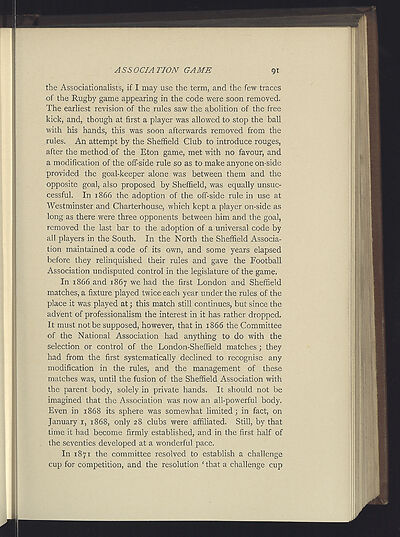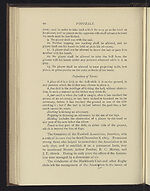Football history
(117)
Download files
Complete book:
Individual page:
Thumbnail gallery: Grid view | List view

ASSOCIATION GAME
9
1
the Associationalists, if I may use the term, and the few traces
of the Rugby game appearing in the code were soon removed.
The earliest revision of the rules saw the abolition of the free
kick, and, though at first a player was allowed to stop the ball
with his hands, this was soon afterwards removed from the
rules. An attempt by the Sheffield Club to introduce rouges,
after the method of the Eton game, met with no favour, and
a modification of the off-side rule so as to make anyone on-side
provided the goal-keeper alone was between them and the
opposite goal, also proposed by Sheffield, was equally unsuc-
cessful. In 1866 the adoption of the off-side rule in use at
Westminster and Charterhouse, which kept a player on-side as
long as there were three opponents between him and the goal,
removed the last bar to the adoption of a universal code by
all players in the South. In the North the Sheffield Associa-
tion maintained a code of its own, and some years elapsed
before they relinquished their rules and gave the Football
Association undisputed control in the legislature of the game.
In 1866 and 1867 we had the first London and Sheffield
matches, a fixture played twice each year under the rules. of the
place it was played at; this match still continues, but since the
advent of professionalism the interest in it has rather dropped.
It must not be supposed, however, that in 1866 the Committee
of the National Association had anything to do with the
selection or control of the London-Sheffield matches ; they
had from the first systematically declined to recognise any
modification in the rules, and the management of these
matches was, until the fusion of the Sheffield Association with
the parent body, solely in private hands. It should not be
imagined that the Association was now an all-powerful body.
Even in 1868 its sphere was somewhat limited; in fact, on
January
1,
1868, only 28 clubs were affiliated. Still, by that
time it had become firmly established, .and in the first half of
the seventies developed at a wonderful pace.
In 1871 the committee resolved to establish a challenge
cup for competition, and the resolution
I
that a challenge cup
9
1
the Associationalists, if I may use the term, and the few traces
of the Rugby game appearing in the code were soon removed.
The earliest revision of the rules saw the abolition of the free
kick, and, though at first a player was allowed to stop the ball
with his hands, this was soon afterwards removed from the
rules. An attempt by the Sheffield Club to introduce rouges,
after the method of the Eton game, met with no favour, and
a modification of the off-side rule so as to make anyone on-side
provided the goal-keeper alone was between them and the
opposite goal, also proposed by Sheffield, was equally unsuc-
cessful. In 1866 the adoption of the off-side rule in use at
Westminster and Charterhouse, which kept a player on-side as
long as there were three opponents between him and the goal,
removed the last bar to the adoption of a universal code by
all players in the South. In the North the Sheffield Associa-
tion maintained a code of its own, and some years elapsed
before they relinquished their rules and gave the Football
Association undisputed control in the legislature of the game.
In 1866 and 1867 we had the first London and Sheffield
matches, a fixture played twice each year under the rules. of the
place it was played at; this match still continues, but since the
advent of professionalism the interest in it has rather dropped.
It must not be supposed, however, that in 1866 the Committee
of the National Association had anything to do with the
selection or control of the London-Sheffield matches ; they
had from the first systematically declined to recognise any
modification in the rules, and the management of these
matches was, until the fusion of the Sheffield Association with
the parent body, solely in private hands. It should not be
imagined that the Association was now an all-powerful body.
Even in 1868 its sphere was somewhat limited; in fact, on
January
1,
1868, only 28 clubs were affiliated. Still, by that
time it had become firmly established, .and in the first half of
the seventies developed at a wonderful pace.
In 1871 the committee resolved to establish a challenge
cup for competition, and the resolution
I
that a challenge cup
Set display mode to:
![]() Universal Viewer |
Universal Viewer | ![]() Mirador |
Large image | Transcription
Mirador |
Large image | Transcription
Images and transcriptions on this page, including medium image downloads, may be used under the Creative Commons Attribution 4.0 International Licence unless otherwise stated. ![]()
| Sports publications > Football history > (117) |
|---|
| Permanent URL | https://digital.nls.uk/231627528 |
|---|
| Description | More than 230 sports publications from the National Library of Scotland's collections. Featured sports include football, rugby, golf, shinty, athletics, bowls, cricket and hockey. Among the material from the late 19th and early 20th centuries are match programmes, club histories, and handbooks. From the late 20th century are promotional materials to encourage greater diversity in sport. Most items cover sports activities in Scotland. There are also publications relating to the Olympics and international matches. |
|---|---|
| Additional NLS resources: |
|

